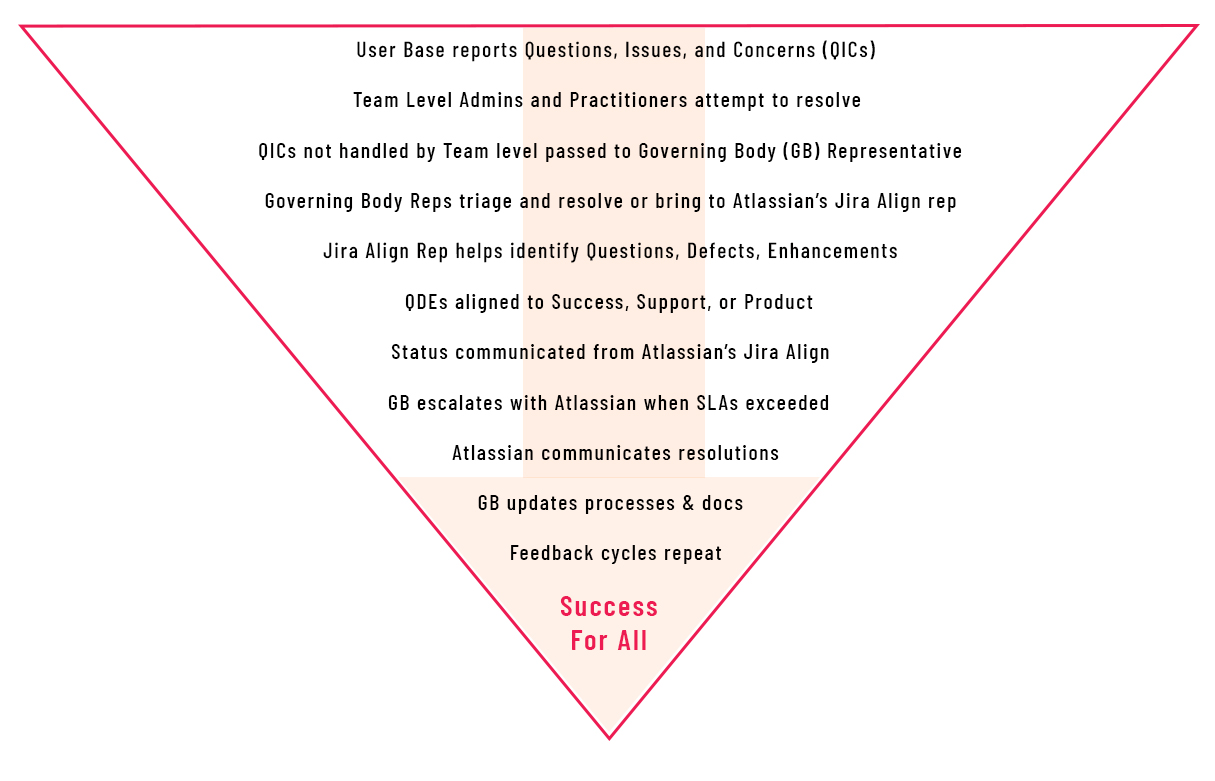Intake and Triage: Jira Align Governance, Part Four
This is the last in a series of four articles regarding Jira Align governance:
To provide context, the first three articles explained the responsibilities and areas of focus for each role making up the Platform Team. The final article explains how each works collaboratively with the other two to effectively support the rest of the organization. While each article will be informative on its own, we highly recommend reading all of them in order to get the big picture.
In parts 1 to 3 of this series, we went into detail about each of the three key roles that make up the Platform Team (or, governing body) responsible to govern the organization’s use of Jira Align.
In this final article, we’ll dissect how this governing body works together to accomplish their goal and produce value for the organization. To do so, we’ll run through the basic steps they follow to handle intake and triage as questions and challenges arise in the use of the solution. You’ll no doubt note the close, collaborative methods used by all three roles as they balance each other out and are able to arrive at the best decision.
What is the purpose of intake and triage?
As the user base is trained up and deployed, they’re going to start having questions and running into challenges. It may just be questions that need an answer, but it can also involve possible defects coming to light in the software or enhancements that would fill gaps in how the solution works.
Ideally, their first line of defense is for practitioners to resolve these situations at the team level relatively quickly. This enhances knowledge and experience while reducing the severity of any bottlenecks impacting the work.
However, if that’s not possible or reaching a resolution is taking too long, the team will escalate questions and challenges to team-level admins, then to the governing body. If the issue involves one or more of the areas of focus listed in the previous articles, the Platform Team role most affected by the topic will usually take the lead in triage. If they’re unable to resolve the situation, they may choose to escalate further to Atlassian (or a partner like Cprime, if that relationship exists.)
Once the issue is resolved, the governing body will take the lead in documenting and communicating the resolution along with any necessary training or process improvement so the entire user base can take advantage.
What does this look like in real life?
Let’s imagine for a moment that the XYZ Corporation is running a relatively new instance of Jira Align. All departments are onboarded and the adoption has gone remarkably smoothly so far (thanks in no small degree to a helping hand from the experts at Cprime!)
However, questions and challenges still arise. For example, a mid-level manager has been poking around inside Jira Align and has located the numerous reports and dashboards related to Objectives and Key Results (OKRs). She feels like this could be a revolutionary tool for the organization to start using, but she quickly realizes it won’t be of much value if everyone isn’t on board with the idea.
So, this becomes a request to be triaged by the Platform Team: “Let’s start using OKRs to establish and track our strategic objectives and use Jira Align to record them.”
Step 1: Tool Administration
Since the genesis of this request revolves around using a feature within the Jira Align software, the Tool Administration representatives take the lead. The first logical question is, “can Jira Align support OKRs?” And, the answer is obviously yes. Jira Align includes various modules, reports, and views centered around creating, tracking, and reporting on OKRs.
So, if they were in a silo as the lone decision-makers, that might be the end of the discussion. The tool is able to do it, so go ahead and do it.
But, fortunately, Tool Administration is just one of three voices on the Platform Team.
Step Two: Business Value
Having established that the tool supports the use of OKRs, the Voice of Business Value now needs to weigh in on whether or not there is any true business value in OKRs as opposed to the milestone-based method they’re currently using.
In this case, some in-depth research and consideration may be required. The entire framework on which the company measures its progress toward strategic objectives is not something to take lightly. And, it’s not unreasonable to imagine the individual or team charged with advocating for business value isn’t already intimately familiar with OKRs and how they compare to what the company uses now. Before offering an opinion, they owe it to the organization to do their due diligence so they can make an informed decision as to what sort of value the company can expect to yield from the change.
Other important factors in that decision will be the level of training required and other change management considerations that will impact ROI, at least in the short term.
So, let’s say the Business Value team has taken several days to do their due diligence and they decide that moving to OKRs could potentially mean big wins down the road. From a value engineering standpoint, it’s a good bet. So, they give it their blessing.
Once again, if the buck stopped at Business Value, OKRs would become the company’s de facto framework for strategic goal setting and tracking. But, there’s still one more leg of the stool on the Platform Team.
Step Three: Framework & Process
The responsibility of the Framework & Process role is to look beyond whether a thing is theoretically possible or profitable and dig down into the nuts and bolts of what it’s actually going to take to accomplish.
The fact that Jira Align happens to support the use of OKRs doesn’t mean the organization’s existing frameworks and processes are conducive to their use. The representatives of Framework & Process will be taking a granular view of what impact this implementation will have on how the organization currently operates. And, where changes are required, what will it take to get from here to there?
They’re going to be considering taxonomy, timeframe, roles, permissions, user access, organizational model, training, enablement, reporting, team configuration, and dozens of other factors that may or may not need to evolve to support the implementation of OKRs company-wide.
In this case, they’re getting some mixed signals but are leaning toward thinking the organization isn’t quite mature enough to make the most of a framework like OKRs. Just to be safe, they run it by their contacts at Cprime with Jira Align expertise. Sure enough, they confirm that the organization is a little too early in their agile journey to truly benefit from moving completely over to OKRs as they’re realized in Jira Align.
Step Four: Making, relaying, and documenting the decision
So, the Framework & Process people relay their recommendation to Business Value and Tool Administration. Tool Administration forwards it on to the originating team with a thorough explanation of why the governing body has decided against the implementation. That mid-level manager who sparked the process can feel some satisfaction in the fact that her request wasn’t just blown off or shuffled across desks.
Perhaps most importantly, however, the Platform Team documents the request and its resulting decision, along with all the research that went into it. After all, Business Value confirmed moving to OKRs would be a good bet. And, Tool Administration verified it’s technically possible already. So, what they’re left with is a gap to fill: the organization’s maturity level in relation to the use of OKRs for strategic goal tracking. They have something to shoot for, and a documented reason to recommend pursuing whatever training, process updates, or change management is required to fill that gap.
As a result, perhaps the company will be ready to move to the use of OKRs in six months or two years. And, at that point, they’ll get even more value from the Jira Align solution. But, in the meantime, they’ll still get the maximum possible value from the portions of the solution that work best for them right now.
To learn more about Jira Align and whether it’s right for your organization, check out our free resources.




